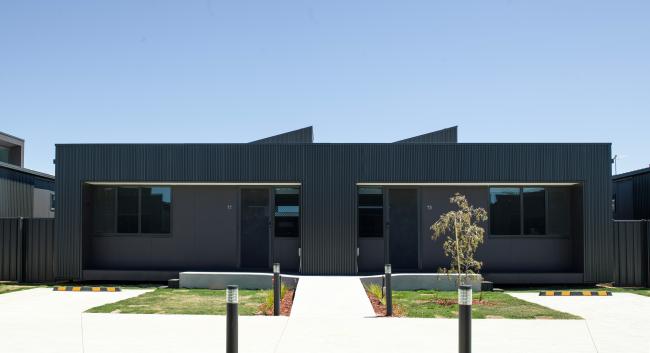
Image courtesy of Haven Home Safe
Haven Home Safe and ARKit collaborate on sustainable modular housing solution
WoodSolutions Timber Framing Campaign Manager, Chris Briggs, is eager to share this good news story. It ticks all the right boxes—supporting social housing, advancing volumetric modular construction, boosting regional housing, and showcasing the benefits of H2F timber framing.
“My perspective is, of course, influenced by the use of termite-resistant timber framing in this modular solution, but this is a project that everyone involved takes great pride in. We want more builders and housing providers to recognise the positive impact timber framing brings. Its ease of use, flexibility, and ready availability are widely known, yet its environmental benefits deserve greater appreciation,” said Chris.

The proud key project participants for this community housing solution include Haven Home Safe, a Victorian community housing provider, who has embraced pioneering modular timber building design from ARKit to deliver 25 new (three one-bedroom, 22 two-bedroom) homes in the regional Victorian town of Horsham.
This groundbreaking development project is a collaborative effort truly worth celebrating, embodying positive impacts across social, community, innovation, and sustainability domains. Haven Home Safe contributes as the community housing provider, ARKit as the modular solution manufacturer, and timber framing has been chosen as the sustainable, low embodied emission structural and construction material.
- Volumetric modular construction solution by ARKit
- Regional housing development
- Constructed with sustainably sourced plantation-grown structural timber value added for termite resistance
Sustainably sourced from plantations, the timber framing in this project was harvested, replanted, and regrown, exemplifying wood as The Ultimate Renewable™ resource. Notably, the timber framing required for an average family home—around 14 cubic meters—is regrown in approximately 150 seconds within Australia’s current plantation estate. Over its lifetime, this timber framing locks up and stores about half of its dry weight as carbon.
“Where practical and appropriate, our new development projects are using sustainably sourced structural timber framing. The added benefit of this project is the speed of modular construction which saves dollars,” said Haven Home Safe Head of Development, Jack Haber.
Jack continued, “Our preference for timber-based structural solutions is about our builders and installers being very comfortable and familiar with the material, noting the Horsham project installation only required two carpenters to install. But it’s also important to note that timber’s sustainability credentials align with Haven Home Safe’s ESG commitments.”

Image courtesy of Haven Home Safe
“Building with a modular prefabricated system offers significant benefits, including a much faster construction speed compared to traditional methods, a lower carbon footprint, and a reduction in construction waste,” said ARKit Managing Director, Craig Chatman.
Craig also noted that modular construction's ability to deliver diverse, value-for-money housing options was a major advantage and a key factor in the Horsham project. This approach aligns well with the needs of social and affordable housing renters, most of whom are seeking smaller, one- to two-bedroom homes.
“It’s also important to note that there’s no compromise on quality in this modularised timber solution we’ve provided in Horsham,” he stated.
Jack Haber, from Haven Home Safe, is well-known by the WoodSolutions team as a long-time advocate for timber construction and a passionate pioneer promoting its potential in emerging markets for both residential and commercial use.
The WoodSolutions Timber Framing campaign aims to encourage Australian builders to take greater pride in using timber framing. Both Jack and Craig’s pioneering approaches and their extensive positive experiences with timber over the years make them genuine advocates for the material—they truly have sawdust in their veins.
Chris explains that a natural conversation emerged when she, Jack, and Craig connected, highlighting how the approaches of Haven Home Safe and ARKit align with the objectives of the WoodSolutions Timber Framing campaign.
Haven Home Safe is a strong advocate not just for increasing the affordable and sustainable housing supply, but also for building connected communities. Placemaking, a core approach they apply to all new builds—including the Horsham project—helps foster a sense of belonging by ensuring safety, promoting community connection, and providing access to green spaces, an important part of resident wellbeing.
For Craig, his 14 years of experience have led him to believe that there are no limits to what prefabricated timber can achieve. With commercially available and reliable supplies of the timber structural elements required for this project, it contributes to an even stronger construction outcome.
Chris adds, "This is also a core message of the WoodSolutions Timber Framing campaign. While we know builders and designers trust timber for its reliability and flexibility, we also want them to take pride in their role in 'building a better world' by promoting the importance of choosing the right structural materials for our homes, particularly in terms of reducing the carbon footprint."
“We want new homeowners to know that their homes have been built with one of the most renewable building materials – timber framing, which also helps fight climate change by storing carbon,” said Chris.
A typical timber-framed home stores over eight tonnes of CO2, absorbed by the tree during its growth, and keeps it locked away for the life of the timber product, including its potential for future reuse. Additionally, the production of timber typically produces less embodied carbon emissions than more carbon-intensive materials, further reinforcing timber's role as a sustainable construction material.
Wood sourced from responsibly managed forests and plantations helps address climate change as harvested trees are replaced with new seedlings, while native forest managers renew their forests through natural or artificial reseeding, supporting the circularity of the entire process.
This project demonstrates the benefits of choosing certified, sustainable timber for people, businesses, and the environment.
